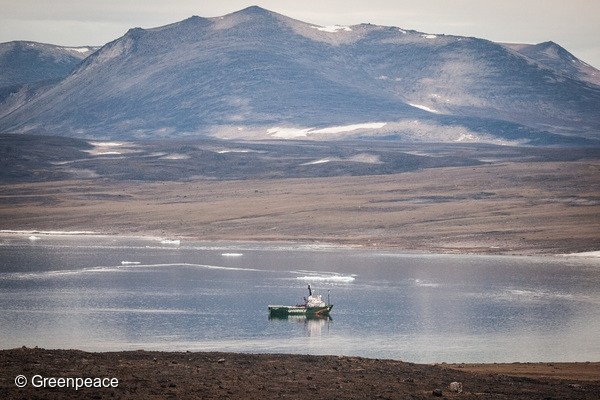By Farrah Khan*
18 August, 2016 (Greenpeace) – The courageous Inuit community of Clyde River is standing up to protect their Arctic home from devastating seismic blasting.
The circumpolar Arctic is home to four million people representing a diversity of cultures. As northerners, they share many connections, but in this year of record breaking high temperatures, one stands out among the rest: the Arctic is warming faster than anywhere else on Earth.
Inevitably, this means daily life for those who live in the Arctic is changing fast, too.

Mayor of Clyde River, James Qillaq, former mayor of Clyde River, Jerry Natanine and Jerry’s daughter, Clara Natanine hold a banner reading “Save the Arctic: it’s our home” on the Greenpeace Arctic Sunrise.
Melting sea ice is opening up new waters that are of immediate interest to the oil industry seeking profit.
But in the eastern Canadian Arctic, one small and mighty community – Clyde River, Nunavut – is taking a stand.
On behalf of Inuit communities from across their territory, they are saying no to dangerous seismic blasting – a process of firing loud underwater air guns into the ocean in search for oil – and they are challenging industry and government in an historic legal battle at Canada’s highest court.

Clara Natanine on the Greenpeace Arctic Sunrise in the Davis Strait.
Two years ago, a seismic blasting project was approved without Inuit consent – a clear violation of their rights as Indigenous Peoples. Through their legal action, the project has been put on hold. But if it were to go ahead, it would cause irreparable harm to many Inuit who depend on healthy marine life.
Three residents of Clyde River and other guests, including whale expert Lindy Weilgart and science educator Chris Williams, have spent nine days sailing aboard the Greenpeace ship Arctic Sunrise through Baffin Bay and Davis Strait – the very part of the Arctic Ocean that Clyde River residents are fighting so hard to protect.

An iceberg glows pink in the sunset in Baffin Bay.
As the ship finally arrived in Clyde River on Monday, Oscar-winning actor and activist Emma Thompson and her daughter Gaia were there to meet it.
They are traveling to the Arctic with Greenpeace for a second time to visit this unique part of the world and learn about the Arctic from its original defenders: the very people who call it home.

Special guests Emma Thompson and Gaia Romilly Wise on board the Greenpeace Arctic Sunrise.
Follow Emma Thompson and her daughter on her journey in the Arctic, and add your name now to support Clyde River’s battle to stop seismic blasting.
*Farrah Khan is an Arctic campaigner at Greenpeace Canada.
A version of this blog was originally posted by Greenpeace Canada.
Farrah Khamn’s report was published in Greenpeace. Go to Original.
2016 Human Wrongs Watch










